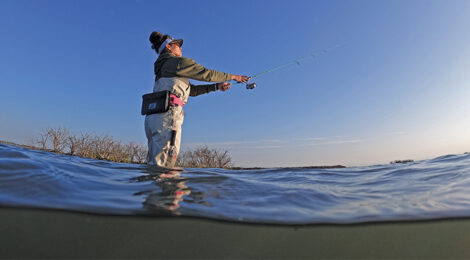
Time of Transition
Fall coastal fishing begins with the weather, which will be changing, plus appropriate adjustments in fishing tactics.
Story and photography by Danno Wise
The weeks leading up to Thanksgiving see a number of changes in Texas bays. It all begins with the weather, which will be changing. This, in turn, will lead to a myriad of other adjustments for coastal fish and fishermen.
Regardless of how hot or mild the summer is or how “early” fall weather arrives, the Texas Coast rarely, if ever, sees truly cooler temperatures on a consistent basis until December. November is the “bridge” month when fronts become more frequent and cooler – even possible cold temperatures become more common.
The weather is often like a yo-yo in November, in the sense that between each front and cool snap temperatures will bounce back up to give warm weather conditions. As the month goes on, the warm spells will be shorter, and the cool spells become more dramatic and cooler.
Most experienced anglers know that weather changes – both in temperature and barometric pressure – influence fishing patterns. This is certainly true during November, as fish will be transitioning from their fall, and at times summer to winter patterns.
To compound this shift in fishing patterns is the yo-yo weather typically seen in November. Given that the weather will be changing on a weekly basis, and sometimes daily or even hourly, fishing will not be set in stone, either with fish reacting to the prevailing or upcoming weather events.
The other factor that needs to be considered is that because it is so early in the “cool” season the water won’t always mirror the air. For example, since water takes a bit longer to cool, a relatively cold, but fast-moving front may do little to nothing to change the water temperature. So, even though air temperatures may drop, the fishing pattern may hold consistent to what it was prior to the front is the water temperature doesn’t dip significantly.
Where fish are found will also be changing throughout the month. Again, sometimes fish will stay longer in some spots based on conditions. Their location, like the weather will yo-yo from day-to-day, although the general trend will see them moving toward deeper water.
In general, fish are able to sense the unstable weather and will begin locating themselves closer to an escape route to the relatively safety of deeper water if and when a cold front pushes through. Most often a temperature drop means fish will fall off flats into the nearest deep water. However, unlike mid-winter, they won’t necessarily stay there too long if water temps don’t plunge dramatically – and they may not move at all if the cold air temperatures aren’t sustained long enough to cool the water.
************************************************************************
To read more, click here to SUBSCRIBE







